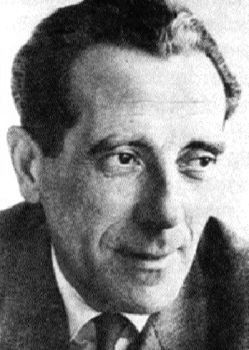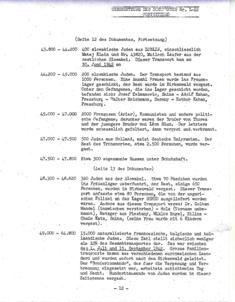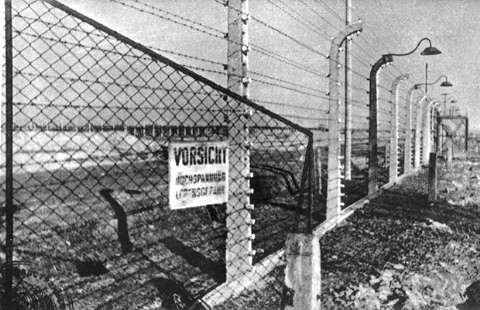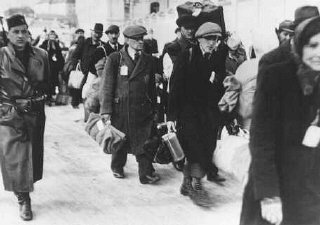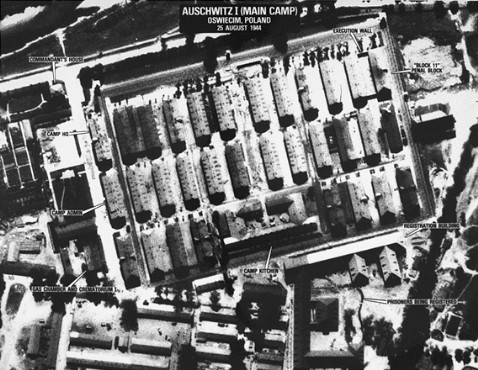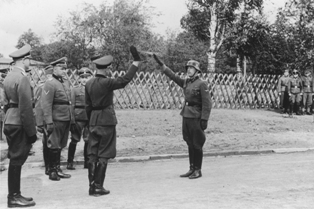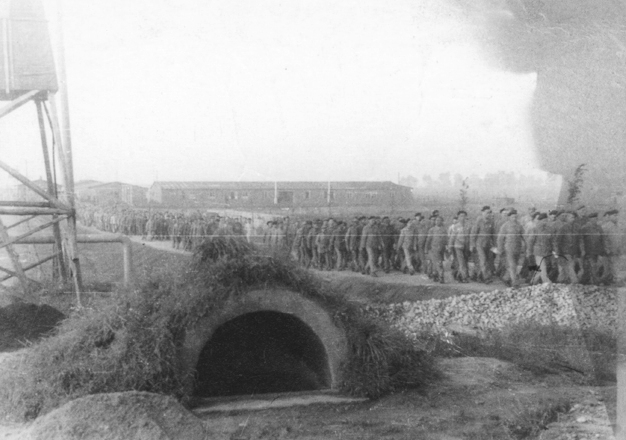Holocaust Education & Archive Research Team |
|
Other Camps
Key Nazi personalities in the Camp System The Labor & Extermination Camps
Auschwitz/Birkenau Jasenovac Klooga Majdanek Plaszow The Labor Camps
Trawniki
Concentration Camps
Transit Camps
| ||||
The Auschwitz Protocol The Vrba-Wetzler Report
[Transcribed from the original O.S.I report of the US Department of Justice & the War Refugee Board Archives] (Photos added to enhance the text)
I. AUSCHWITZ AND BIRKENAU
ON THE 13TH April, 1942 our group, consisting of 1,000 men, was loaded into railroad cars at the assembly camp of SERED. The doors were shut so that nothing would reveal the direction of the journey, and when they were opened after a long while we realized that we had crossed the Slovak frontier and were in ZWARDON.
The train had until then been guarded by Hlinka men, but was now taken over by SS guards. After a few of the cars had been uncoupled from our convoy, we continued on our way arriving at night at AUSCHWITZ, where we stopped on a sidetrack.
The reason the other cars were left behind was apparently the lack of room at AUSCHWITZ. They joined us, however, a few days later. Upon arrival we were placed in rows of five and counted. There were 643 of us. After a walk of about 20 minutes with our heavy packs (we had left Slovakia well equipped), we reached the concentration camp of AUSCHWITZ.
We were at once led into a huge barrack where on the one side we had to deposit all our luggage and on the other side completely undress and valuables behind. Naked, we then proceeded to an adjoining barrack where our heads and bodies were shaved and disinfected with Lysol. At the exit every man was given a number which began with 28,600 in consecutive order
With this number in hand we were then herded to a third barrack where so-called registration took place. This consisted of tattooing the numbers we had received in the second barrack on the left side of our chests. The extreme brutality with which this was effected made many of us faint. The particulars of our identity were" also recorded.
Then we were put in groups of a hundred into a cellar, and later to a barrack W here we were issued striped prisoners' clothes and wooden dogs. This lasted until 10 a.m. In the afternoon our prisoners' outfits were taken away from us again and replaced by the ragged and dirty remains of Russian uniforms. Thus equipped we were marched off to BIRKENAU.
AUSCHWITZ is a concentration camp for political prisoners under so-called "protective custody." At the time of my arrival, that is in April of 1942, there were about 15,000 prisoners in the :amp, the majority of whom were Poles, Germans, and civilian Russians under protective custody. A small number of prisoners came under the categories of criminals and "work-shirkers."
AUSCHWITZ camp headquarters controls at the same time the work camp of BIRKENAU as well as the farm labor camp of HARMENSE. All the prisoners arrive first at AUSCHWITZ where they are provided with prisoners' matriculation numbers and then are either kept there, sent to BIRKENAU or, in very small numbers, to HARMENSE.
The prisoners receive consecutive numbers upon arrival. Every number is only used once so that the last number always corresponds to the number of prisoners actually in the camp. At the time of our escape, that is to say at the beginning of April, 1944, the number had risen up to 180,000. At the outset the numbers were tattooed on the left breast, but later, due to their becoming blurred, on the left forearm.
All prisoners, irrespective of category or nationality, are treated the same. However, to facilitate identification, they are distinguished by various colored triangles sewed on the clothing on the left breast under the matriculation number. The first letter indicates the nationality of the prisoner.
This letter (for instance "P" for Poles) appears in the middle of the triangle. The colored triangles have the following meaning:
The Jewish prisoners differ from the Aryan prisoners in that their triangle (which in the majority of cases is red) is turned into a David's star by adding yellow points.
The prisoners' actual living quarters, if such a term may at all be used, inside the camp proper cover an area of approximately 500 by 300 meters surrounded by a double row of concrete posts about 3 meters high which are connected (both inside and outside) with one another by a dense netting of high-tension wires fixed into the posts by insulators. Between these two rows of posts, at intervals of 150 meters, there are 5 meters high watchtowers, equipped with machine guns and searchlights.
In front of the inner high-tension circle there is further an ordinary wire fence. Merely touching this fence is answered by a stream of bullets from the watchtowers. This system is called "the small or inner chain of sentry posts." The camp itself is composed 0 three rows of houses. Between the first and second row is the camp street, and between the second and third there used to low a wall.
The Jewish girls deported from Slovakia in March nod April, 1942, over 7,000 of them, lived in the house separated by this wall up to the middle of August, 1942. After these girls had been removed to BIRKENAU, the wall between the second and and third row of houses was removed.
The camp entry road cuts across the row of houses, while over the entrance gate, which is of course always heavily guarded, stands the ironic inscription: "Work brings freedom." At a radius of some 2,000 meters the whole camp is encircled by a second line called "the big or outer chain of sentry posts" also with watchtowers every 150 meters. Between the inner and outer chain of sentry posts are the factories and other workshops.
The towers of the inner chain are only manned at night when the high-tension current is switched into the double row of wires. During daytime the garrison of the inner chain of sentry posts is withdrawn, and the men take up duty in the outer chain. Escape through these sentry posts-and many attempts have been made is practically impossible.
Getting through the inner circle of posts at night is completely impossible, and the towers of the outer chain are so close to one another (one every 150 meters, i.e., giving each tower a sector with a 75-meter radius to watch) that approaching unnoticed is out of the question. The guards shoot without warning. The garrison of the outer chain is withdrawn at twilight, but only after it has been ascertained that all the prisoners are within the inner circle. If the roll call reveals that a prisoner is missing, sirens immediately sound the alarm.
The escapee is furthermore handicapped by his clean-shaven head, his striped prisoner's outfit or red patches sewn on his clothing, and the passiveness of the thoroughly intimidated inhabitants.
The mere fact of neglecting to give information on the whereabouts of a prisoner, not to speak of extending help, is punished by death.
Provided that the prisoner has not been caught sooner, the garrison of the outer chain of sentry posts remains on the watch for three days and nights after which delay it is presumed that the escapee has succeeded in breaking through the double circle. The following night the outer guard is withdrawn.
If the escapee is caught alive, he is hanged in the presence of the whole camp; but if he is found dead, his body wherever it may have been located-is brought back to camp (it is easy to identify the corpse by means of the tattooed number) and seated at the entrance gate, a small notice clasped in his hands, reading: "Here I am."
During our two years' imprisonment many attempts to escape were made by prisoners but, with the exception of two or three, all were brought back dead or alive. It is not known whether the two or three escapees who were not caught actually managed to get away. It can, however, be asserted that among the Jews who were deported from SLOVAKIA to AUSCHWITZ or BIRKENAU we are the only two who were lucky enough to save ourselves.
The existing camp center of BIRKENAU lies 4 kilometers distant from AUSCHWITZ. The outer control zones of both BIRKENAU and AUSCHWITZ meet and are merely separated by a railway track. We never found anything out about NEW BERUN, probably about 30 to 40 kilometers away which, odd I enough, we had to indicate as postal district for BIRKENAU,
All are built according to a standard model: A house is about 30 meters long and 8 to 10 meters wide. Whereas the height of the walls hardly exceeds 2 meters, the roof is disproportionately high-about 5 meters-so that the house gives the impression of a stable surmounted by a large hayloft.
There is no inner ceiling, so that the room reaches a height of 7 meters in the center; in other words the pointed roofing rests directly on the four walls. The room is divided in two by a partition running its whole length down the middle and fitted with opening to enable communication between the two parts thus separated.
Along both sidewalls, as well as along the middle partition, two parallel floors, some 80 centimeters apart, have been built which are in turn divided into small cells by vertical partitions.
Thus there are three floors: the ground floor and the two built in the sidewalls. Normally three people live in each cubicle. As can be judged from the dimensions indicated, these cubicles are too narrow for a man to lie stretched out and not high enough for him to sit upright.
There is no question of having enough space to stand upright. In this way 400 to 500 people are accommodated in one house or "block," as they are also called.
Within a radius of 2 kilometers, as with AUSCHWITZ, BIIRKENAU is also surrounded by an other chain of sentry posts with the same type of watch system as at AUSCHWITZ.
They were numbered from 1 to 12,000 in a series which had no connection with the ordinary camp numbering system previously described. Whenever fresh convoys of Russian prisoners arrived, they were not issued the current AUSCHWITZ prisoner numbers, but received those of deceased Russians in the 1 to 12,000 series.
It is, therefore, difficult to estimate how many prisoners of this category passed through the camp. Apparently Russians were transferred to AUSCHWITZ or BIRKENAU on disciplinary grounds from regular prisoners-of-war camps. We found what remained of the Russians in a terrible state of destitution and neglect living the unfinished building without the slightest protection against cold or rain. They died "en-masse". Hundreds and thousands of their bodies were buried superficially, spreading a stench of pestilence. Later we had to exhume the corpses and burn them.
A week before our arrival in AUSCHWITZ the first group of Jews reached the camp: (the women were dealt with separately and received numbers parallel to those of the men; the Slovak women received serial numbers from 1 to 8,000) 1,320 naturalized French Jews from Paris. They were numbered from 27,500 onwards.
It is clear, therefore, that between this French group and our convoy no other men arrived in AUSCHWITZ, since we have already pointed out that our numbers started with 28,600. We found the 700 French Jews who were still alive in terrible condition, the missing 600 having died within a week after their arrival.
Working conditions were inconceivably hard, so that the majority of III weakened by starvation and the inedible food, could not stand it. The mortality was so high that every day our group of 200 had 30 to 35 dead. Many were simply beaten to death by the overseers-the "Capos"-during work, without the slightest provocation.
The gaps in our ranks caused by these deaths were replaced daily by prisoners from BIRKENAU. Our return at night was extremely painful and dangerous, as we had to drag along over a distance of 5 kilometers our tools, firewood, heavy caldrons, and the bodies of those who had died or had been killed during the working day. With these heavy loads we were forced to maintain a brisk pace, and anyone incurring the displeasure of one of the "Capos" was cruelly knocked down, if not beaten to death.
Until the arrival of the second group of Slovak men some 14 days later, our original number had dwindled to 150. At night we were counted, the bodies of the dead were piled up on flat, narrow-gauge cars or in a truck and brought to the Birch Forest (BRZEZINSKI) where they were burned in a trench several meters deep and about 15 meters long.
As I had in the meantime managed to work my way up to a good position in BIRKENAU -being in command of a group of 50 men, which had brought me a considerable advantage-I at first felt reluctant to leave for AUSCHWITZ. However, I was finally persuaded to go and left.
After eight days, 18 doctors and attendants as well as three further persons were selected from this group of 120 intellectuals. The doctors were used in the "sick building" or "hospital" at AUSCHWITZ, while we three were sent back to BIRKENAU.
My two comrade, Ladislav Braun from Trnava and Gross from Vrbove' , both of whom have since died, were sent to the Slovak block while I was ordered to the French section where we were employed collecting "personal data" and at "nursing" the sick. The remaining 99 prisoners were sent to work in the gravel pit where they all died within a short time.
Continued in [Part II]
Sources: War Refugee Board at the F.D. Roosevelt Library, New York, NY Holocaust Historical Society
Copyright: Carmelo A. Lisciotto H.E.A.R.T 2008
|

